Landslides Susceptibility Assessment Based on GIS Statistical Bivariate Analysis in the Hills Surrounding a Metropolitan Area
Abstract
1. Introduction
2. Materials and Methods
2.1. Study Area
2.2. Database and Methodology
- Ln, Tan—mathematical identifiers
- Accumulation—flow accumulation
- 25—the area in m2 of the DEM cell
- slope—slope in radians
- Ii—statistical value of the i factor
- Si—area with identified landslides within each considered variable
- Ni—area of the analysed variable category within the studied territory
- S—total area affected by landslides within the studied territory
- N—the studied area in km2
3. Results
3.1. Altitude Factor
3.2. Slope Factor
3.3. Slope Orientation Factor
3.4. Distance to Settlements Factor
3.5. Distance to Roads Factor
3.6. Distance to Hydrography Factor
3.7. Wetness Index Factor
3.8. Stream Power Index Factor
3.9. Land-Use Factor
3.10. Geology Factor
3.11. Depth of Fragmentation Factor
3.12. Density of Fragmentation Factor
3.13. Cumulated Landslide Susceptibility Analysis
4. Discussion
4.1. Model Validation
4.2. General Considerations
5. Conclusions
Author Contributions
Funding
Acknowledgments
Conflicts of Interest
References
- Armaș, I. An analytic multicriteria hierarchical approach to assess landslide vulnerability. Case study: Cornu Village/Romania. Z. Geomorphol. 2011, 55, 209–229. [Google Scholar] [CrossRef]
- Bilaşco, Ş.; Horvath, C.; Cocean, P.; Sorocovschi, V.; Oncu, M. Implementation of the USLE model using GIS techniques. Case study the Somesean Plateau. Carpath. J. Earth Environ. Sci. 2009, 4, 123–132. [Google Scholar]
- Petrea, D.; Bilasco, S.; Rosca, S.; Vescan, I.; Fodorean, I. The determination of the landslide occurrence probability by GIS spatial analysis of the land morphometric characteristics (Case Study: The Transylvanian Plateau). Carpath. J. Earth Environ. Sci. 2014, 9, 91–102. [Google Scholar]
- Bălteanu, D.; Micu, M. Landslide investigation: From morphodynamic mapping to hazard assessment. A case-study in the Romanian Subcarpathians: Muscel Catchment. In Landslide Process. From Geomorphologic Mapping to Dynamic Modelling; Malet, J.P., Remaitre, A., Bogaard, T., Eds.; CERG Editions: Strasbourg, France, 2009; pp. 235–241. [Google Scholar]
- Irimuș, I.-A.; Roșca, S.; Rus, M.-I.; Marian, F.L.; Bilașco, S. Landslide susceptibility assessment in Almas Basin by means of the frequency rate and GIS techniques. Geogr. Technol. 2017, 12, 97–109. [Google Scholar] [CrossRef]
- Varnes, D.J. Slope movement types and processes. In Special Report 176: Landslides: Analysis and Control Transportation and Road Research Board; Schuster, R.L., Krizek, R.J., Eds.; National Academy of Science: Washington, DC, USA, 1978; pp. 11–33. [Google Scholar]
- Cruden, D.M.; Varnes, D.J. Landslides types and processes. In Landslides Investigation and Mitigation; Special Report, 247; Turner, A.K., Schuster, R.L., Eds.; Transportation Research Board, National Research Council: Washington, DC, USA, 1996; pp. 36–75. [Google Scholar]
- Jaedicke, C.; Van Den Eeckhaut, M.; Nadim, F.; Hervás, J.; Kalsnes, B.; Vangelsten, B.V.; Smith, J.T.; Tofani, V.; Ciurean, R.; Winter, M.G. Identification of landslide hazard and risk ‘hotspots’ in Europe. Bull. Eng. Geol. Environ. 2014, 73, 325–339. [Google Scholar] [CrossRef]
- Carrara, A.; Cardinali, M.; Guzzetti, F.; Reichenbach, P. GIS-based technology in mapping landslide hazard. In Geographical Information Systems in Assessing Natural Hazards; Carrara, A., Guzzetti, F., Eds.; Kluwer Acad. Publications: Dordrecht, The Netherlands, 1995; pp. 135–176. [Google Scholar]
- Dai, F.; Lee, C.; Ngai, Y.Y. Landslide risk assessment and management: An overview. Eng. Geol. 2002, 64, 65–87. [Google Scholar] [CrossRef]
- Spalevic, V.; Lakicevic, M.; Radanovic, D.; Billi, P.; Barovic, G.; Vujacic, D.; Sestras, P.; Khaledi Darvishan, A. Ecological-economic (Eco-Eco) modelling in the River Basins of Mountainous Regions: Impact of land cover changes on sediment yield in the Velicka Rijeka, Montenegro. Not. Bot. Horti Agrobo. 2017, 45, 602–610. [Google Scholar] [CrossRef]
- Carrara, A.; Guzzetti, F.; Cardinali, M.; Reichenbach, P. Use of GIS technology in the prediction and monitoring of landslide hazard. Nat. Hazards 1999, 20, 117–135. [Google Scholar] [CrossRef]
- Coe, J.A.; Godt, J.W.; Baum, R.L.; Bucknam, R.C.; Michael, J.A. Landslide susceptibility from topography in Guatemala. In Landslides: Evaluation and Stabilization; Lacerda, W.A., Ehrlich, M., Fontura, S.A.B., Sayao, A.S.F., Eds.; Taylor & Francis Group: London, UK, 2004; Volume 1, pp. 69–78. [Google Scholar]
- Coe, J.A.; Michael, J.A.; Crovelli, R.A.; Savage, W.Z.; Laprade, W.T.; Nashem, W.D. Probabilistic assessment of precipitation-triggered landslides using historical records of landslide occurrence, Seattle, Washington. Environ. Eng. Geosci. 2004, 10, 103–122. [Google Scholar] [CrossRef]
- Magliulo, P.; Di Lisio, A.; Russo, F.; Zelano, A. Geomorphology and landslide susceptibility assessment using GIS and bivariate statistics: A case study in southern Italy. Nat. Hazards 2008, 47, 411–435. [Google Scholar] [CrossRef]
- Jebur, M.N.; Pradhan, B.; Shafri, H.Z.M.; Yusoff, Z.M.; Tehrany, M.S. An integrated user-friendly ArcMAP tool for bivariate statistical modelling in geoscience applications. Geosci. Model Dev. 2015, 8, 881–891. [Google Scholar] [CrossRef]
- Jebur, M.N.; Pradhan, B.; Tehrany, M.S. Detection of vertical slope movement in highly vegetated tropical area of Gunung pass landslide, Malaysia, using L-band InSAR technique. Geosci. J. 2014, 18, 61–68. [Google Scholar] [CrossRef]
- Jebur, M.N.; Pradhan, B.; Tehrany, M.S. Using ALOS PALSAR derived high-resolution dinsar to detect slow-moving landslides in tropical forest: Cameron highlands, Malaysia. Geomat. Nat. Hazards Risk 2015, 6, 741–759. [Google Scholar] [CrossRef]
- Borrelli, L.; Ciurleo, M.; Gullà, G. Shallow Landslide Susceptibility Assessment in Granitic Rocks Using Gis-Based Statistical Methods: The Contribution of the Weathering Grade Map. Landslides 2018, 15, 1127–1142. [Google Scholar] [CrossRef]
- Ciurleo, M.; Cascini, L.; Calvello, M. A comparison of statistical and deterministic methods for shallow landslide susceptibility zoning in clayey soils. Eng. Geol. 2017, 223, 71–81. [Google Scholar] [CrossRef]
- Fell, R.; Corominas, J.; Bonnard, C.; Cascini, L.; Leroi, E.; Savage, W.Z. Guidelines for landslide susceptibility, hazard and risk zoning for land-use planning. Eng. Geol. 2008, 102, 99–111. [Google Scholar] [CrossRef]
- Radoane, M.; Radoane, N. Geomorfologie Aplicată; Editura University Suceava: Suceava, Romania, 2007; p. 378. [Google Scholar]
- Roșca, S. Bazinul Nirajului. Studiu de Geomorfologie Aplicată; Editura Risoprint: Cluj-Napoca, Romania, 2015; p. 384. [Google Scholar]
- Sestras, P.; Bondrea, M.; Cetean, H.; Sălăgean, T.; Bilaşco, Ş.; Naș, S.; Spalevic, V.; Fountas, S.; Cîmpeanu, S. Ameliorative, ecological and landscape roles of Făget Forest, Cluj-Napoca, Romania, and possibilities of avoiding risks based on GIS landslide susceptibility map. Not. Bot. Horti Agrobo. 2018, 46, 292–300. [Google Scholar] [CrossRef]
- Ercanoglu, M.; Kasmer, O.; Temiz, N. Adaptation and comparison of expert opinion to analytical hierarchy process for landslide susceptibility mapping. Bull. Eng. Geol. Environ. 2008, 67, 565–578. [Google Scholar] [CrossRef]
- Roșca, S.; Bilașco, S.; Petrea, D.; Vescan, I.; Fodorean, I.; Filip, S. Application of landslide hazard scenarios at annual scale in the Niraj River basin (Transylvania Depression, Romania). Nat. Hazards 2015, 77, 1573. [Google Scholar] [CrossRef]
- Van Westen, C.J.; Rengers, N.; Soeters, R. Use of geomorphological information in indirect landslide susceptibility assessment. Nat. Hazards 2003, 30, 399–419. [Google Scholar] [CrossRef]
- Thiery, Y.; Malet, J.-P.; Sterlacchini, S.; Puissant, A.; Maquaire, O. Landslide susceptibility assessment by bivariate methods at large scales: Application to a complex mountainous environment. Geomorphology 2007, 92, 38–59. [Google Scholar] [CrossRef]
- Bilaşco, Ş.; Roşca, S.; Păcurar, I.; Moldovan, N.; Boţ, A.; Negrușier, C.; Sestras, P.; Bondrea, M.; Naș, S. Identification of Land Suitability for Agricultural Use by Applying Morphometric and Risk Parameters Based on GIS Spatial Analysis. Not. Bot. Horti Agrobo. 2016, 44, 302–312. [Google Scholar] [CrossRef]
- Roșca, S.; Bilașco, S.; Petrea, D.; Vescan, I.; Fodorean, I. Comparative assessment of landslide susceptibility. Case study: The Niraj river basin (Transylvania depression, Romania). Geomat. Nat. Hazards Risk 2016, 7, 1043–1064. [Google Scholar] [CrossRef]
- Moldovan, N.; Păcurar, I.; Bilașco, S.; Roșca, S.; Boț, A. The analysis of vulnerability to landslides in order to determine the risk on farmland. Case study: Intercommunity association area for development Alba Iulia. ProEnviroment 2015, 8, 356–546. [Google Scholar]
- Chalkias, C.; Ferentinou, M.; Polykretis, C. GIS Supported Landslide Susceptibility Modeling at Regional Scale: An Expert-Based Fuzzy Weighting Method. ISPRS Int. J. Geo-Inf. 2014, 3, 523–539. [Google Scholar] [CrossRef]
- Sarkar, S.; Kanungo, D.P. An integrated approach for landslide susceptibility mapping using remote sensing and GIS. Photogramm. Eng. Rem. Sens. 2004, 70, 617–625. [Google Scholar] [CrossRef]
- Sestraş, P.; Sălăgean, T.; Bilașco, S.; Bondrea, M.V.; Naș, S.; Fountas, S.; Cîmpeanu, S.M. Prospect of a GIS based digitization and 3D model for a better management and land use in a specific micro-areal for crop trees. Environ. Eng. Manag. J. accepted.
- Beven, K.J.; Kirkby, M.J. A physically based, variable contributing area model of basin hydrology. Hydrol. Sci. Bull. 1979, 24, 43–69. [Google Scholar] [CrossRef]
- Moore, I.D.; Wilson, J.P. Length-slope factors for the revised universal soil loss equation: Simplified method of estimation. J. Soil Water Conserv. 1992, 47, 423–428. [Google Scholar]
- Yin, K.L.; Yan, T.Z. Statistical prediction model for slope instability of metamorphosed rocks. In Proceedings of the 5th International Symposium on Landslides, Lausanne, Switzerland, 10–15 July 1988; Bonnard, C., Ed.; Balkema: Rotterdam, The Netherlands, 1988; Volume 2, pp. 1269–1272. [Google Scholar]
- Jade, S.; Sarkar, S. Statistical models for slope instability classification. Eng. Geol. 1993, 36, 91–98. [Google Scholar] [CrossRef]
- Dolean, B.E. Landslide susceptibility assessment using Spatial Analysis and GIS modeling in Cluj-Napoca Metropolitan Area, Romania. Cinq Cont. 2017, 7, 23–41. [Google Scholar]
- Roșca, S.; Bilaşco, S.; Păcurar, I.; Oncu, M.; Negruşier, C.; Petrea, D. Land capability classification for crop and fruit product assessment using GIS technology. Case study: The Niraj River Basin (Transylvania Depression, Romania). Not. Bot. Horti Agrobo. 2015, 43, 235–242. [Google Scholar] [CrossRef]
- Guzzetti, F.; Reichenbach, P.; Cardinali, M.; Galli, M.; Ardizzone, F. Probabilistic landslide hazard assessment at the basin scale. Geomorphology 2005, 72, 272–299. [Google Scholar] [CrossRef]
- Vakhshoori, V.; Zare, M. Is the ROC curve a reliable tool to compare the validity of landslide susceptibility maps? Geomat. Nat. Hazards Risk 2018, 9, 249–266. [Google Scholar] [CrossRef]
- Wang, Q.; Wang, D.; Huang, Y.; Wang, Z.; Zhang, L.; Guo, Q.; Chen, W.; Chen, W.; Sang, M. Landslide Susceptibility Mapping Based on Selected Optimal Combination of Landslide Predisposing Factors in a Large Catchment. Sustainability 2015, 7, 16653–16669. [Google Scholar] [CrossRef]
- Zhou, S.; Chen, G.; Fang, L.; Nie, Y. GIS-Based Integration of Subjective and Objective Weighting Methods for Regional Landslides Susceptibility Mapping. Sustainability 2016, 8, 334. [Google Scholar] [CrossRef]
- Ahmed, B.; Dewan, A. Application of Bivariate and Multivariate Statistical Techniques in Landslide Susceptibility Modeling in Chittagong City Corporation, Bangladesh. Remote Sens. 2017, 9, 304. [Google Scholar] [CrossRef]
- Assilzadeh, H.; Levy, J.K.; Wang, X. Landslide catastrophes and disaster risk reduction: A GIS framework for landslide prevention and management. Remote Sens. 2010, 2, 2259–2273. [Google Scholar] [CrossRef]
- Corominas, J.; van Westen, C.; Frattini, P.; Cascini, L.; Malet, J.-P.; Fotopoulou, S.; Catani, F.; van den Eeckhaut, M.; Mavrouli, O.; Agliardi, F.; et al. Recommendations for the quantitative analysis of landslide risk. Bull. Eng. Geol. Environ. 2014, 73, 209–263. [Google Scholar] [CrossRef]
- Jeong, S.; Kassim, A.; Hong, M.; Saadatkhah, N. Susceptibility Assessments of Landslides in Hulu Kelang Area Using a Geographic Information System-Based Prediction Model. Sustainability 2018, 10, 2941. [Google Scholar] [CrossRef]
- Ciurleo, M.; Mandaglio, M.C.; Moraci, N. Landslide susceptibility assessment by TRIGRS in a frequently affected shallow instability area. Landslides 2019, 16, 175. [Google Scholar] [CrossRef]
- Kerekes, A.-H.; Poszet, S.L.; Gál, A. Landslide susceptibility assessment using the maximum entropy model in a sector of the Cluj-Napoca Municipality, Romania. Rev. Geomorf. 2018, 20, 130–146. [Google Scholar] [CrossRef]
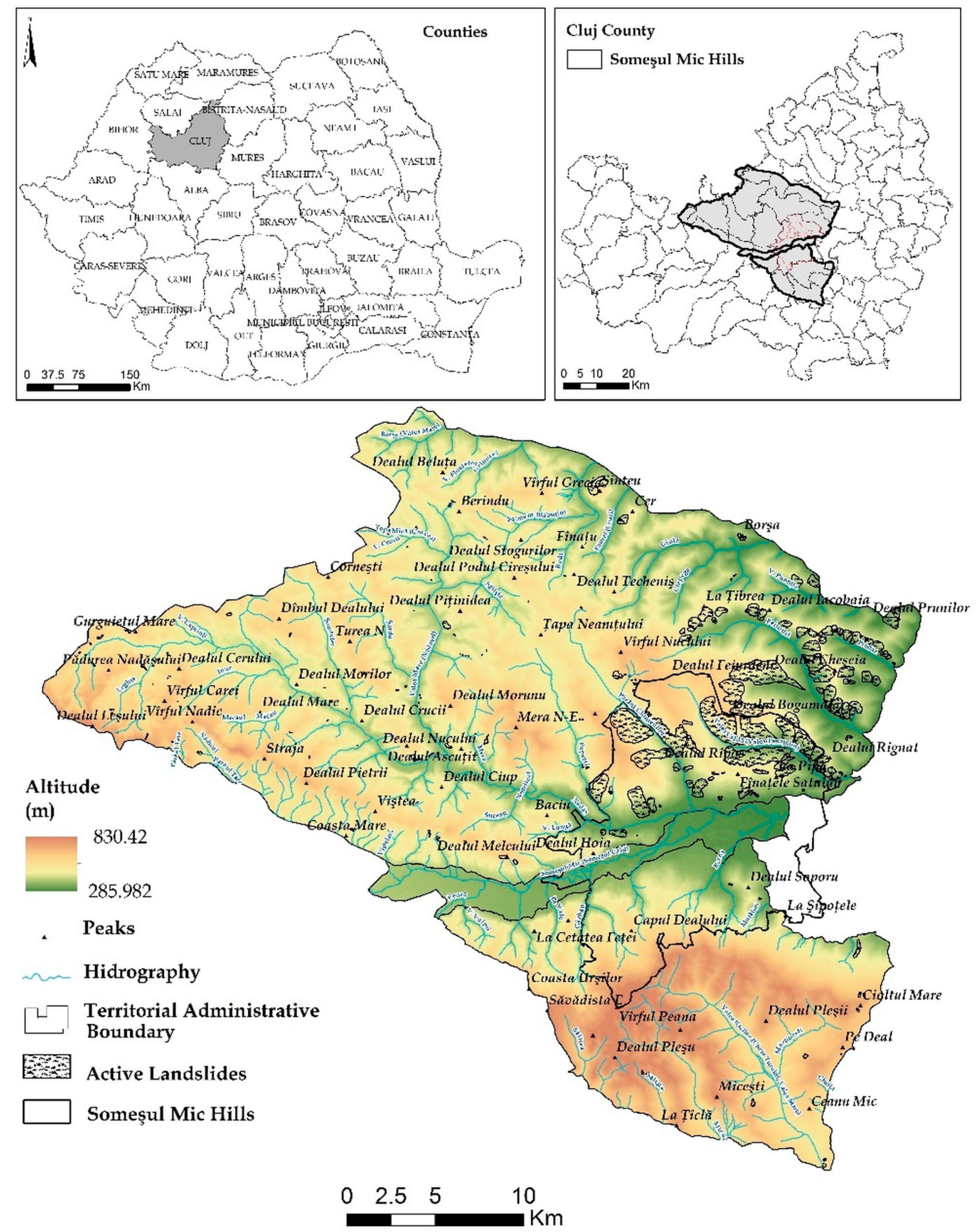
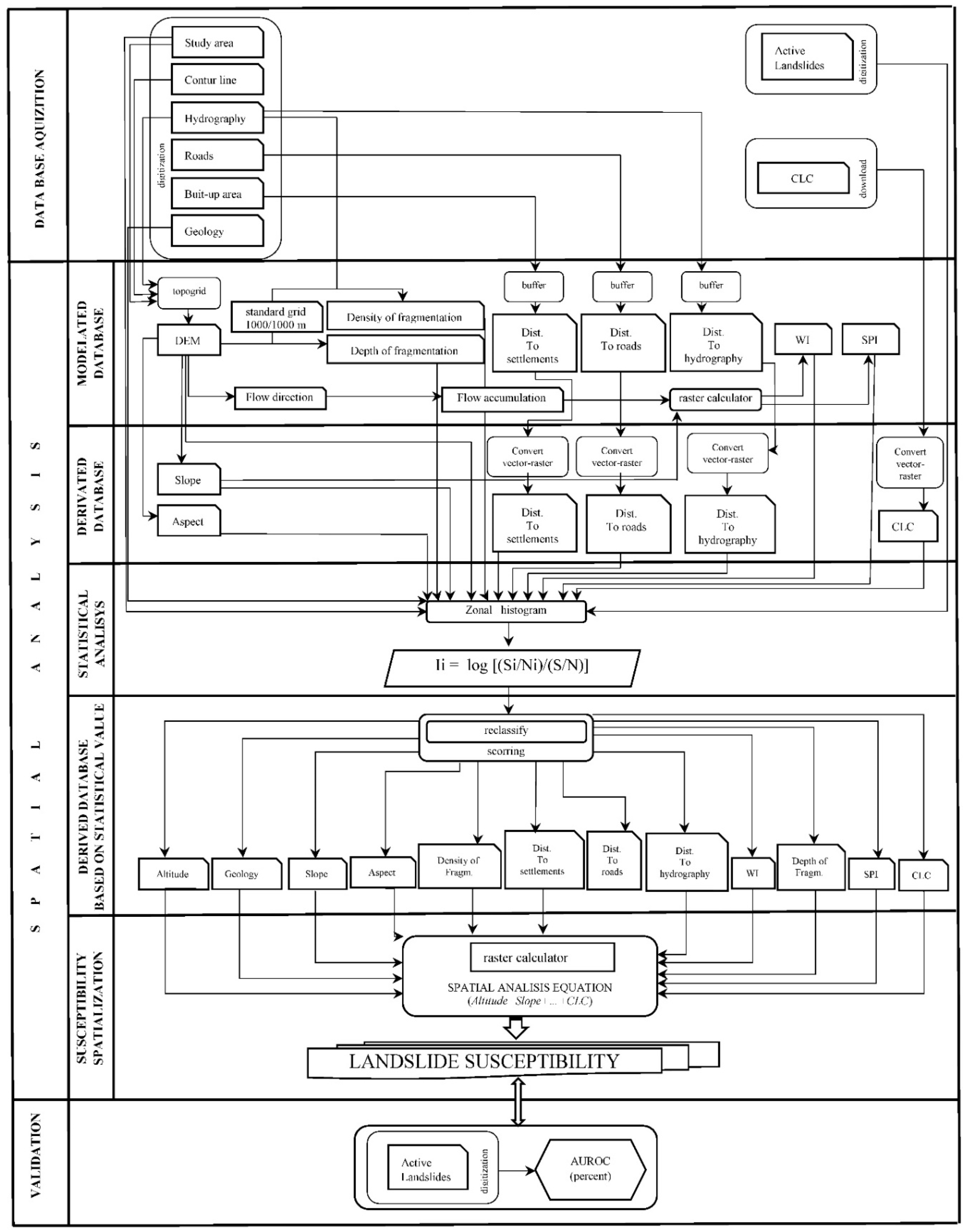
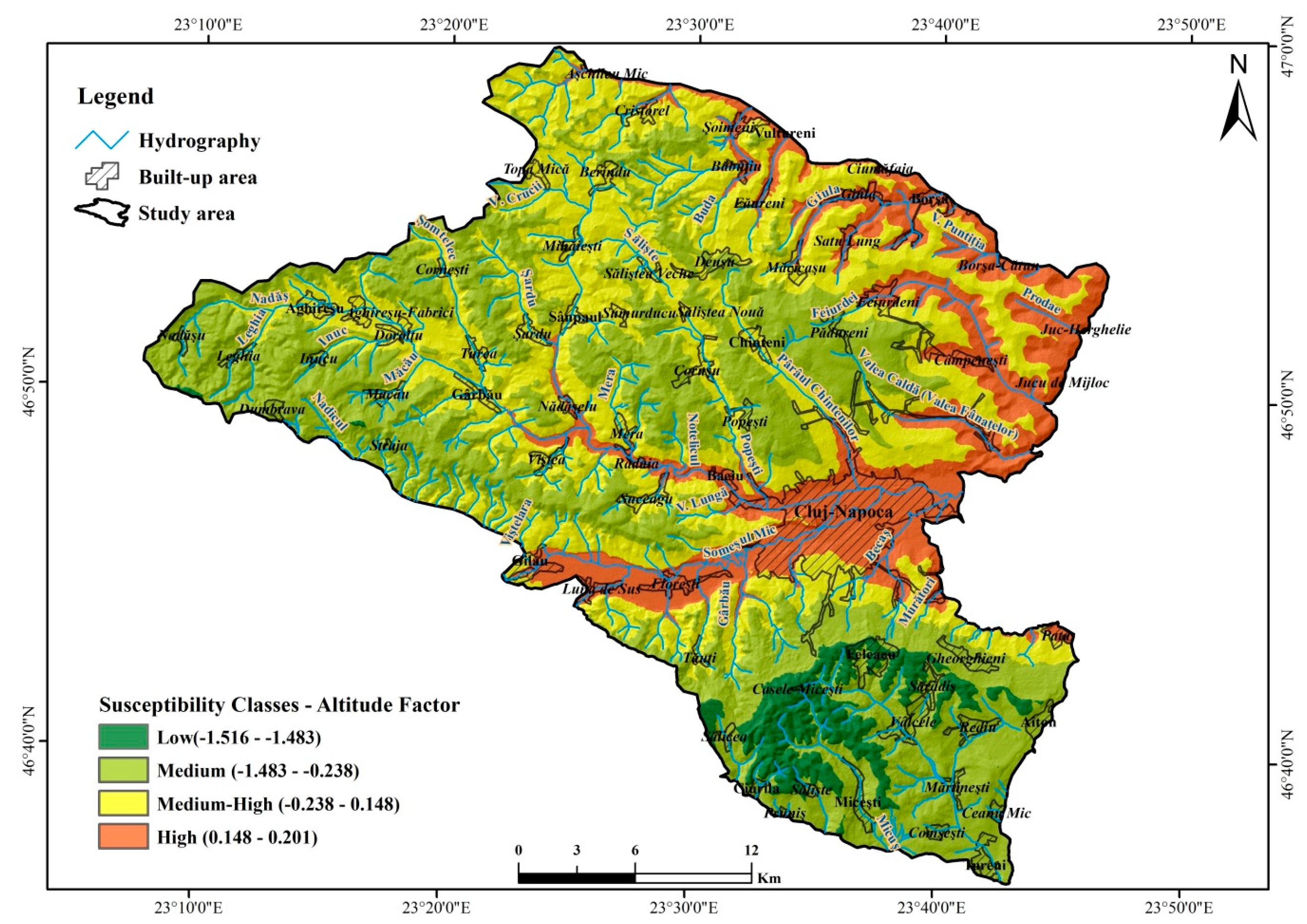
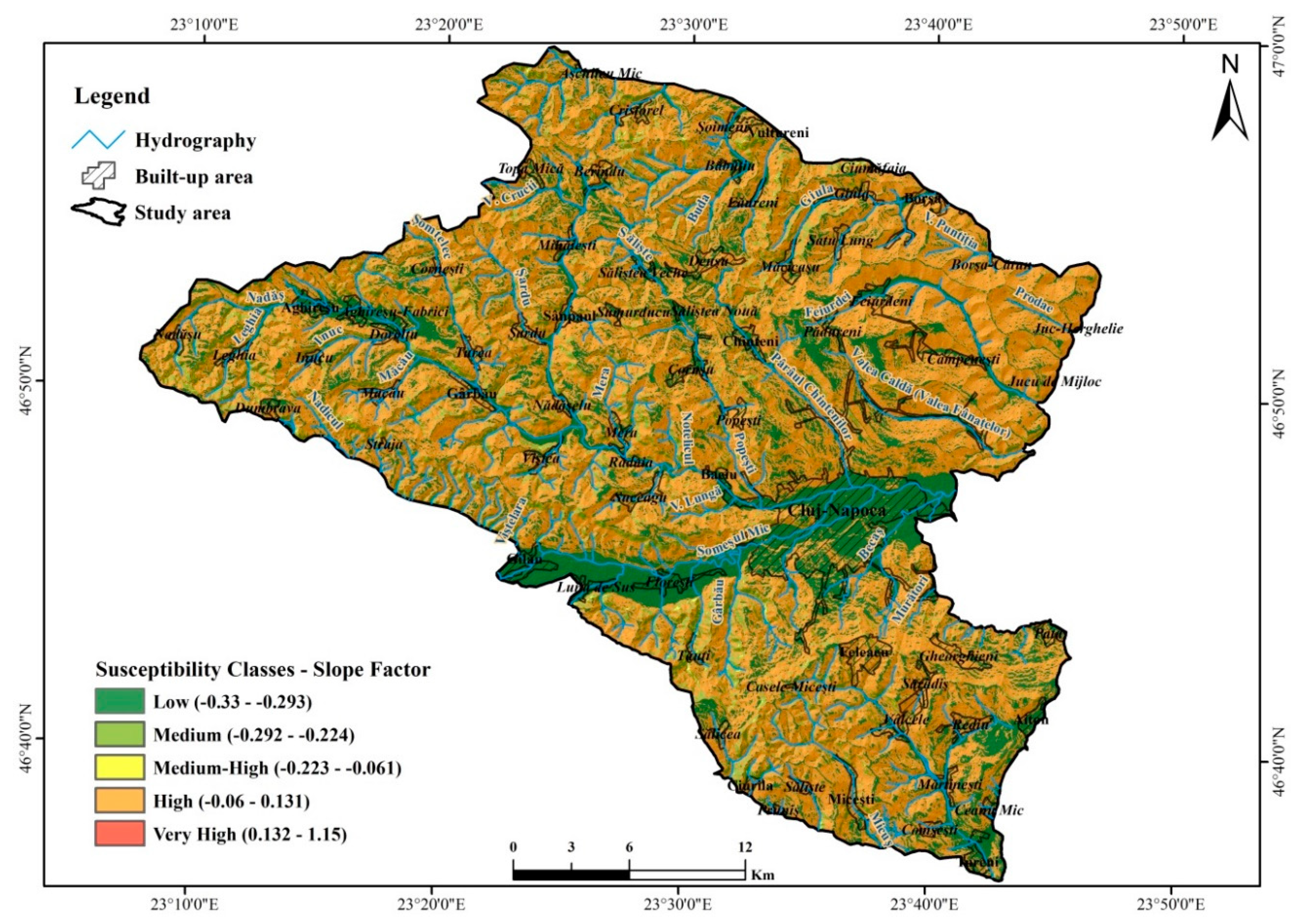


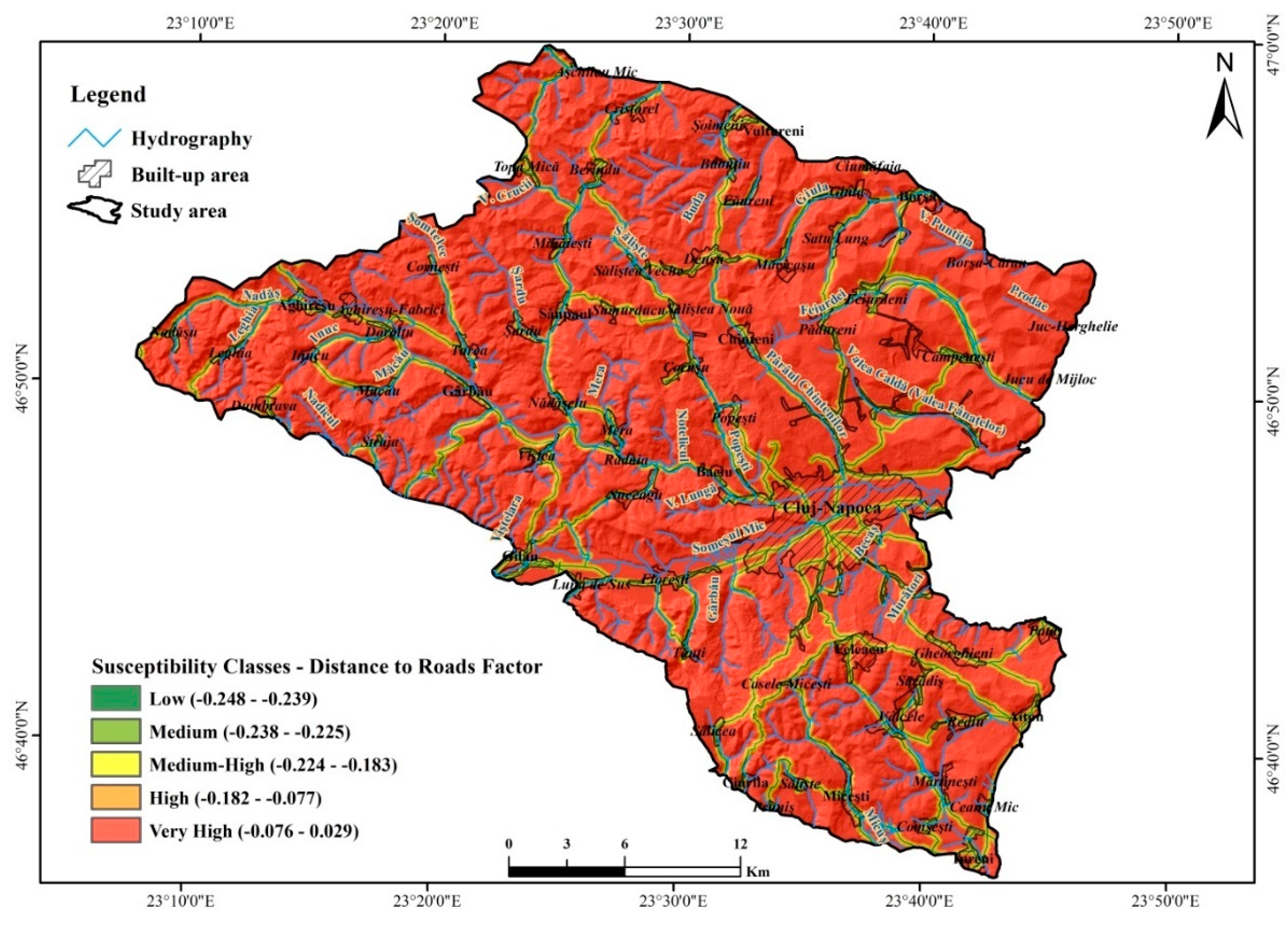
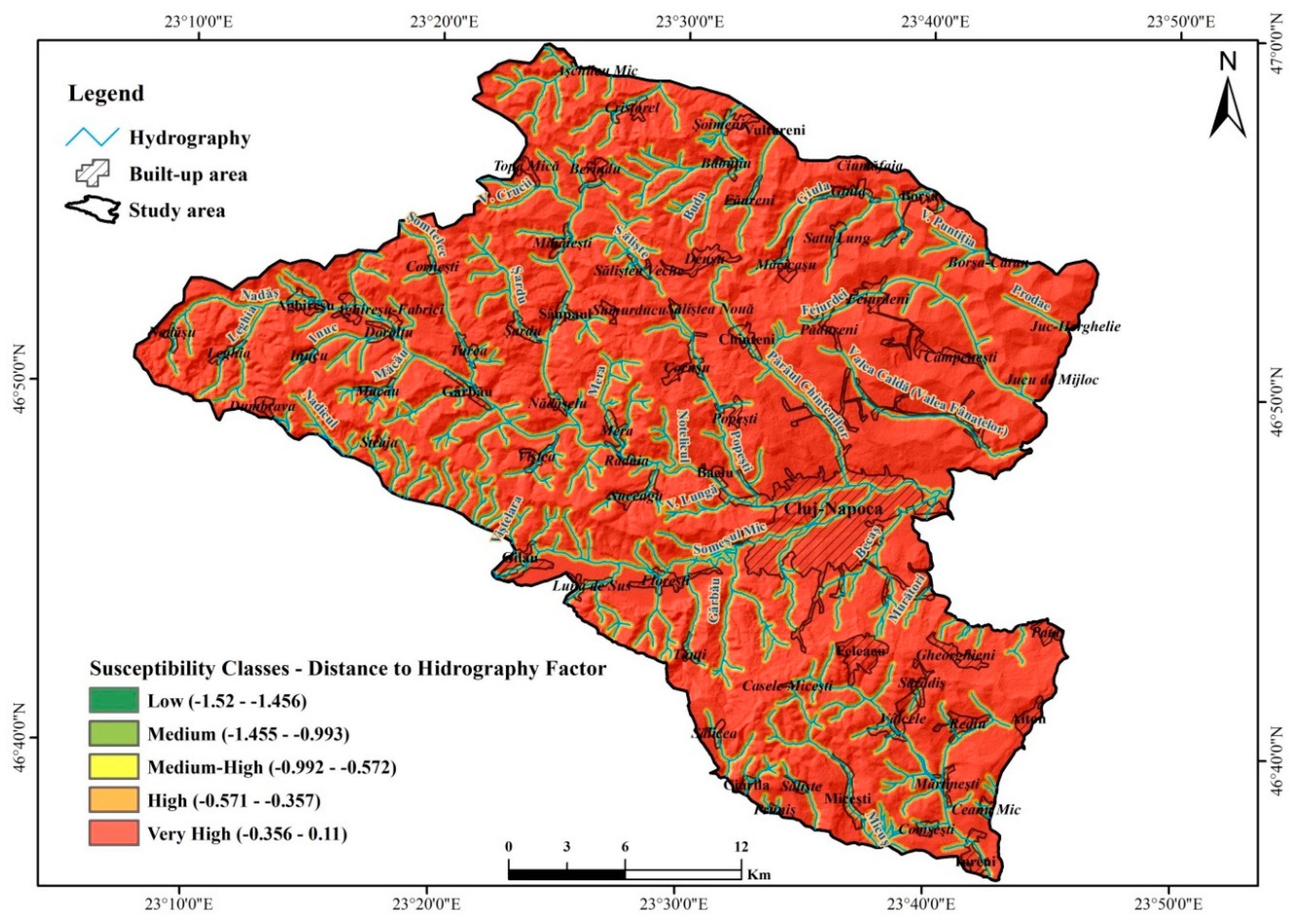
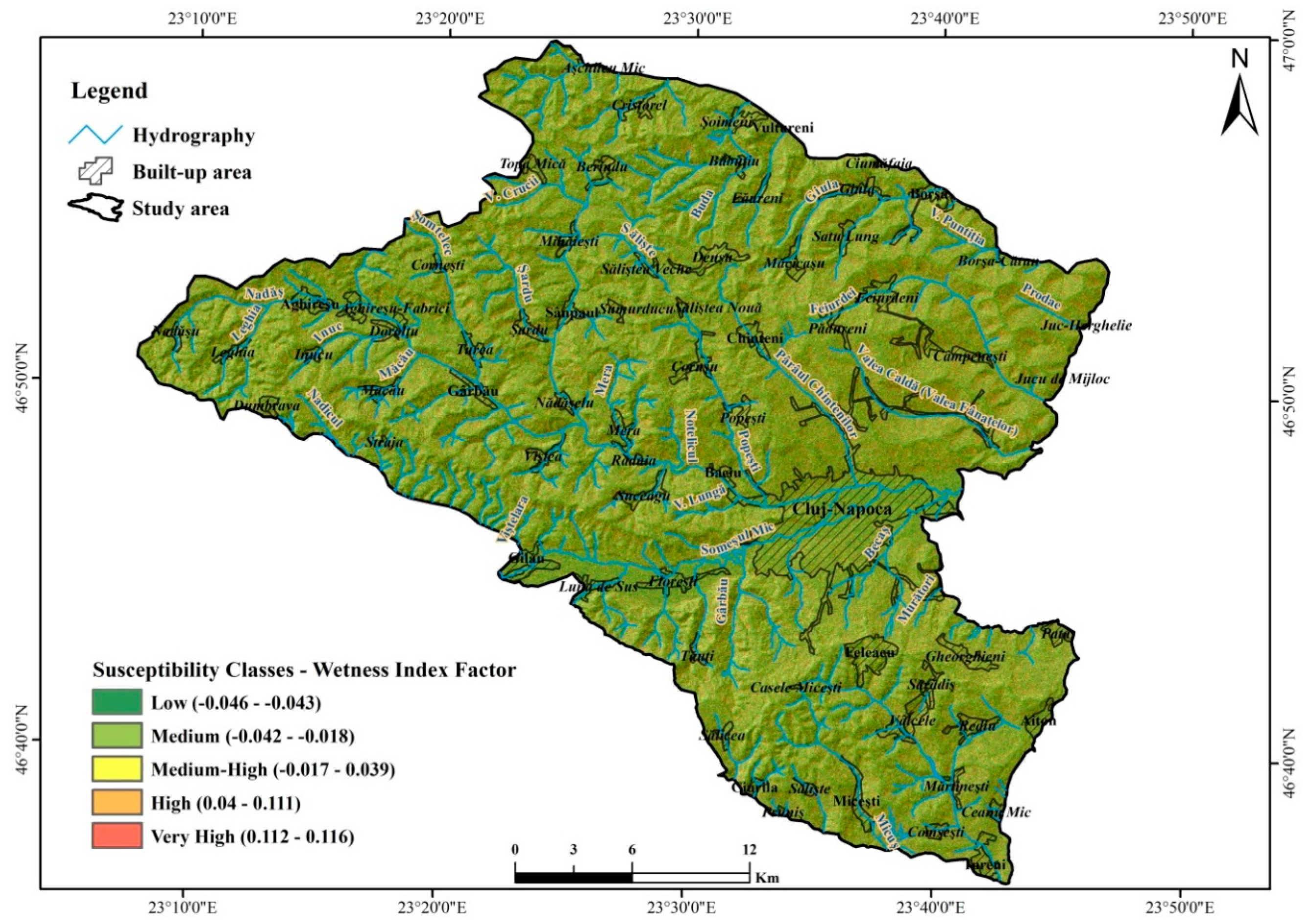

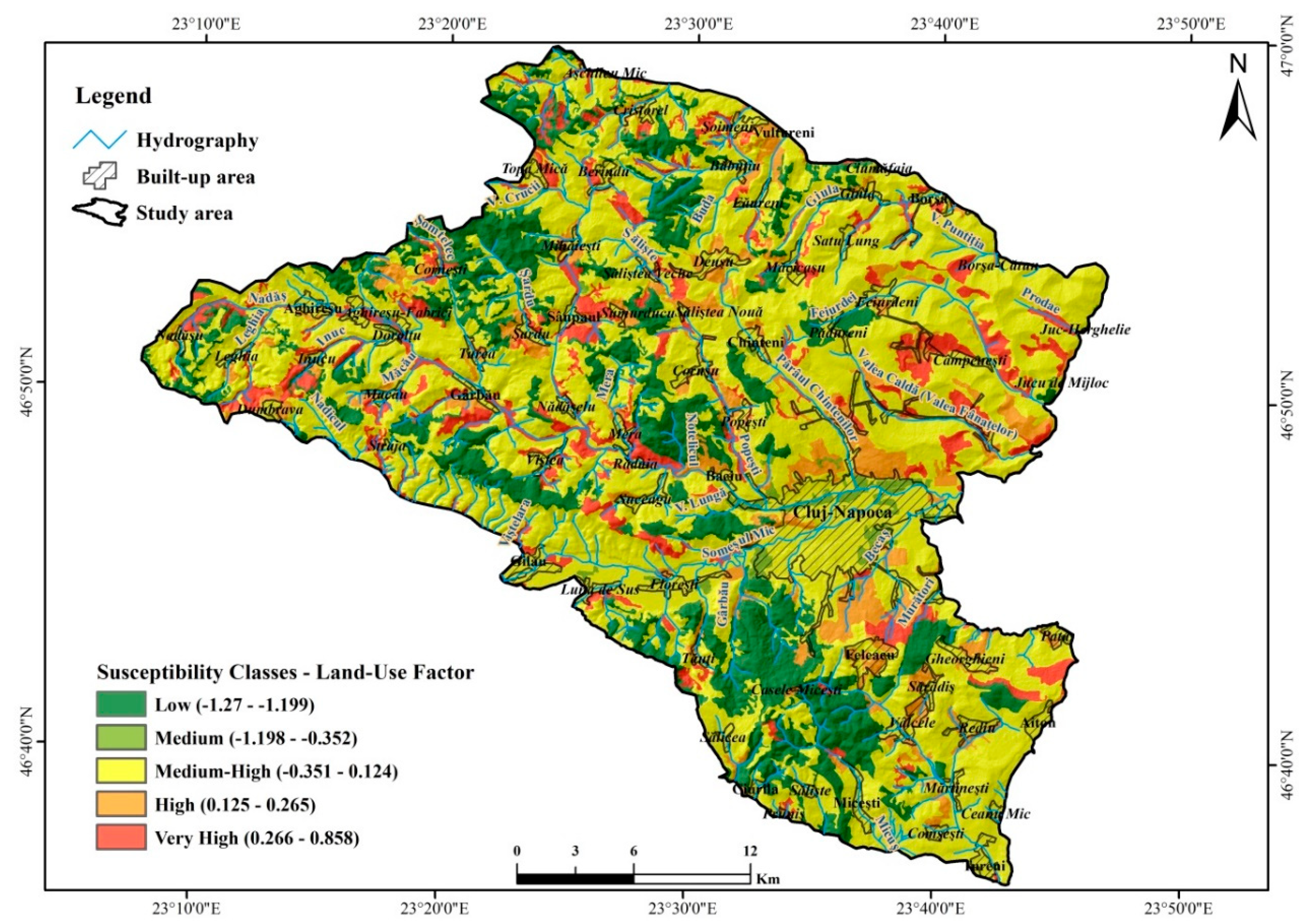
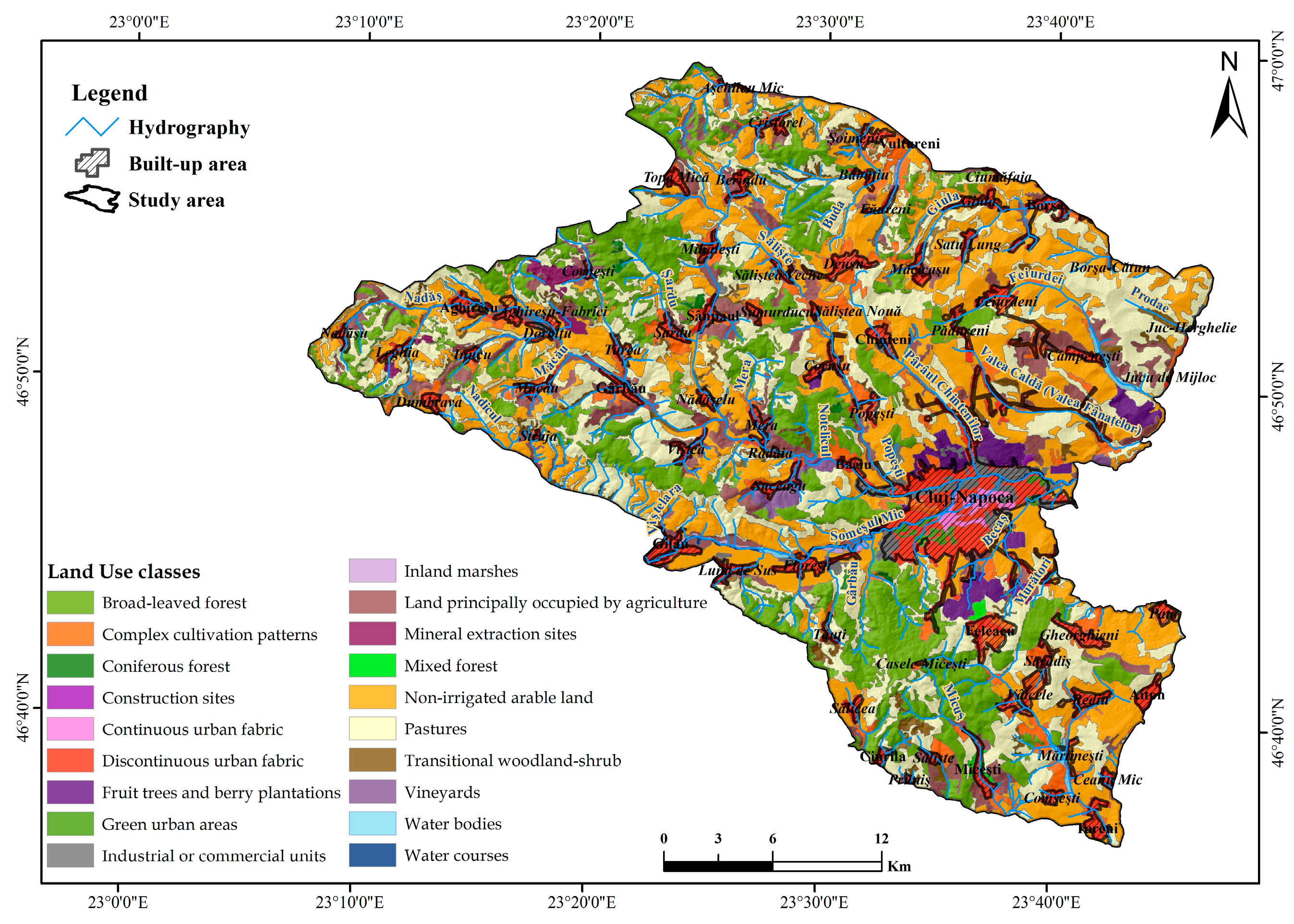

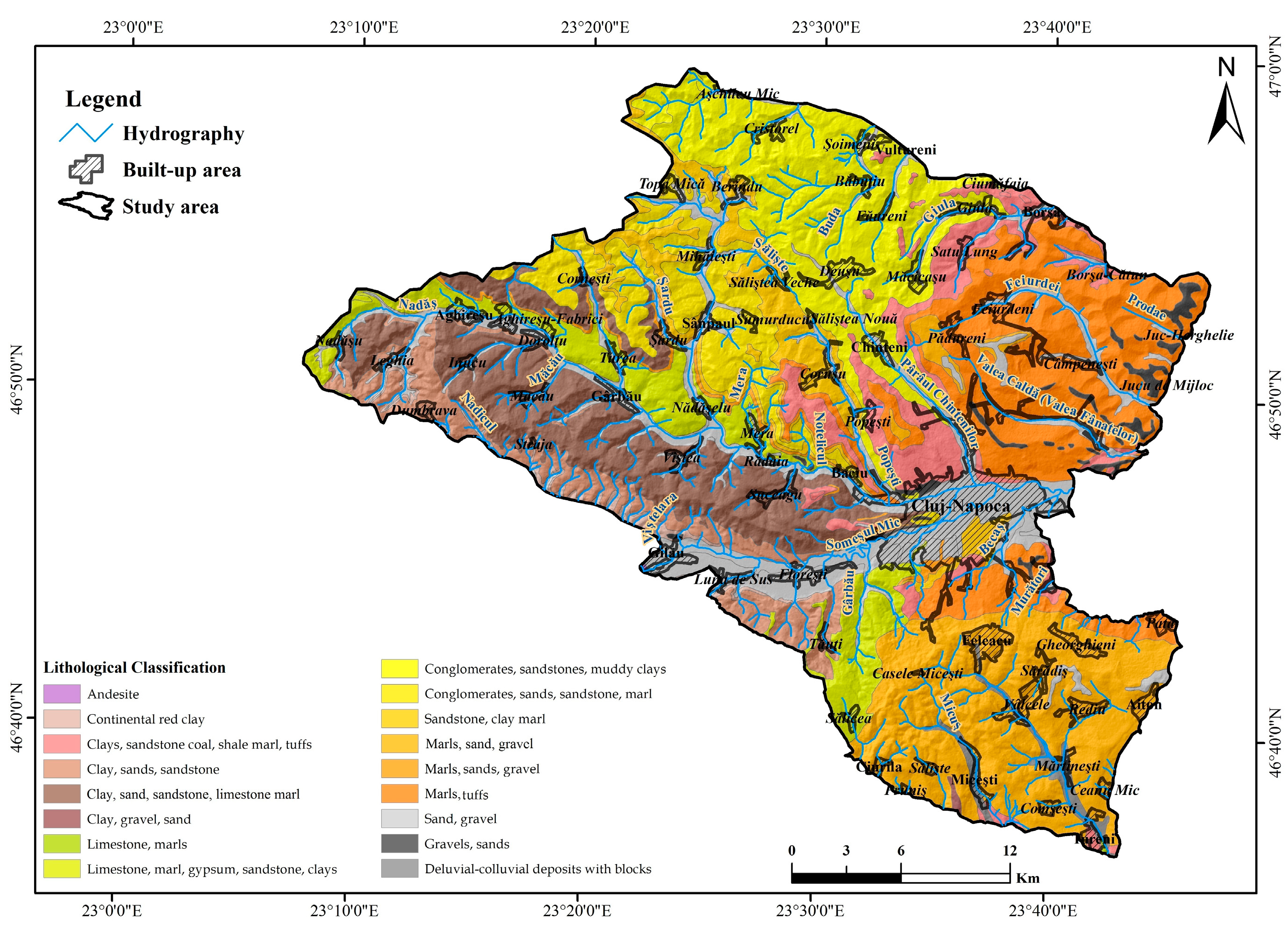
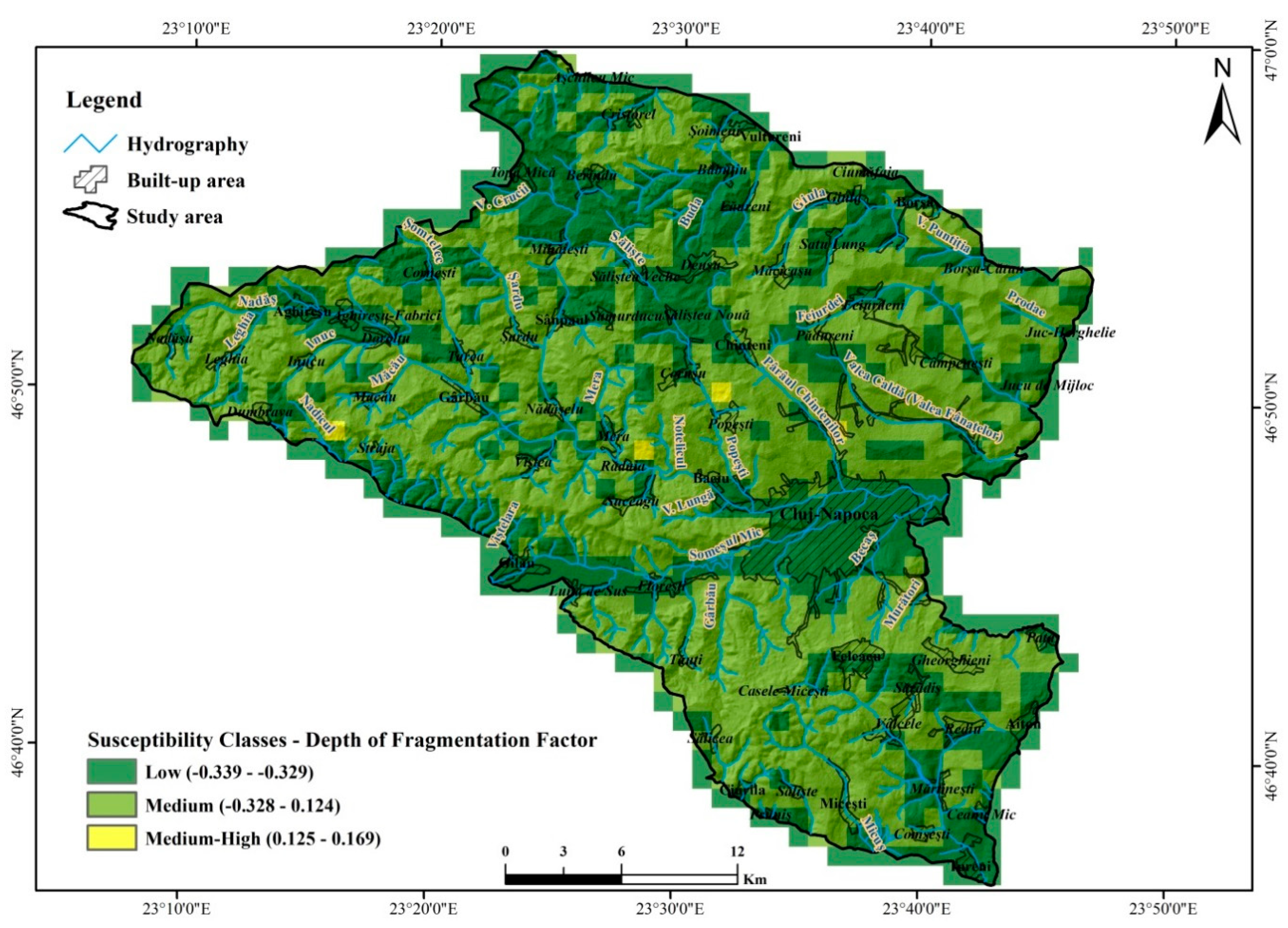
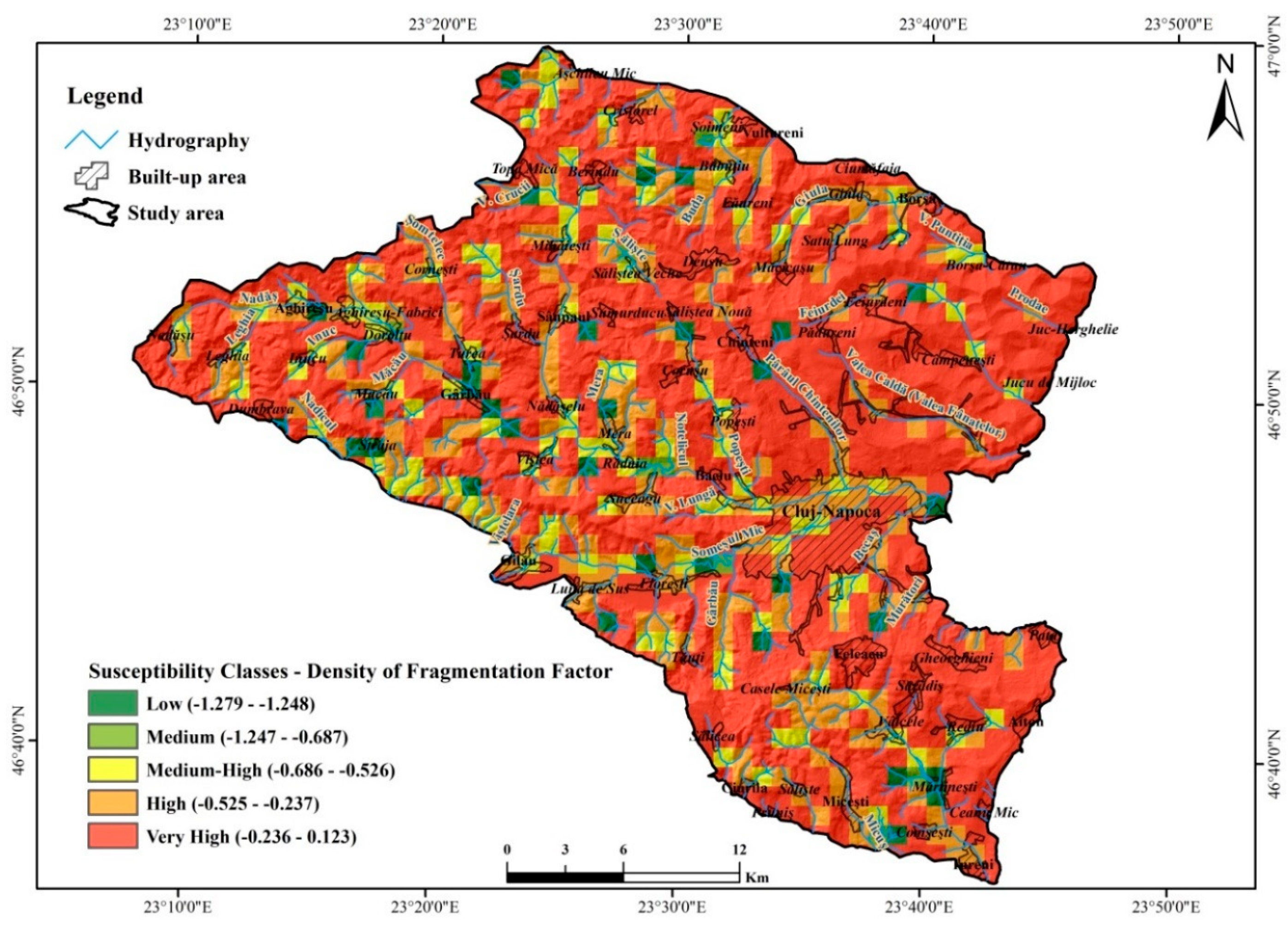
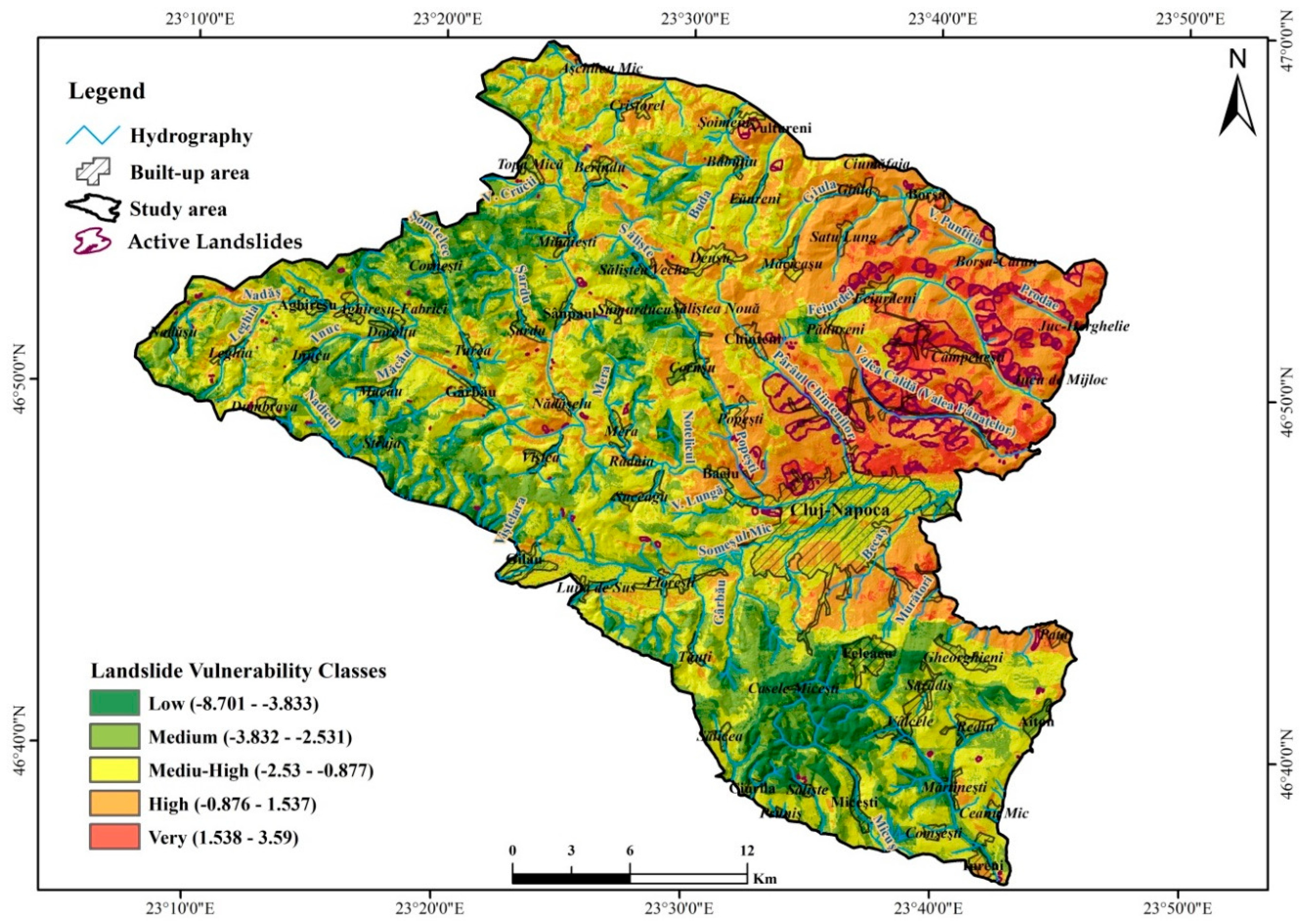
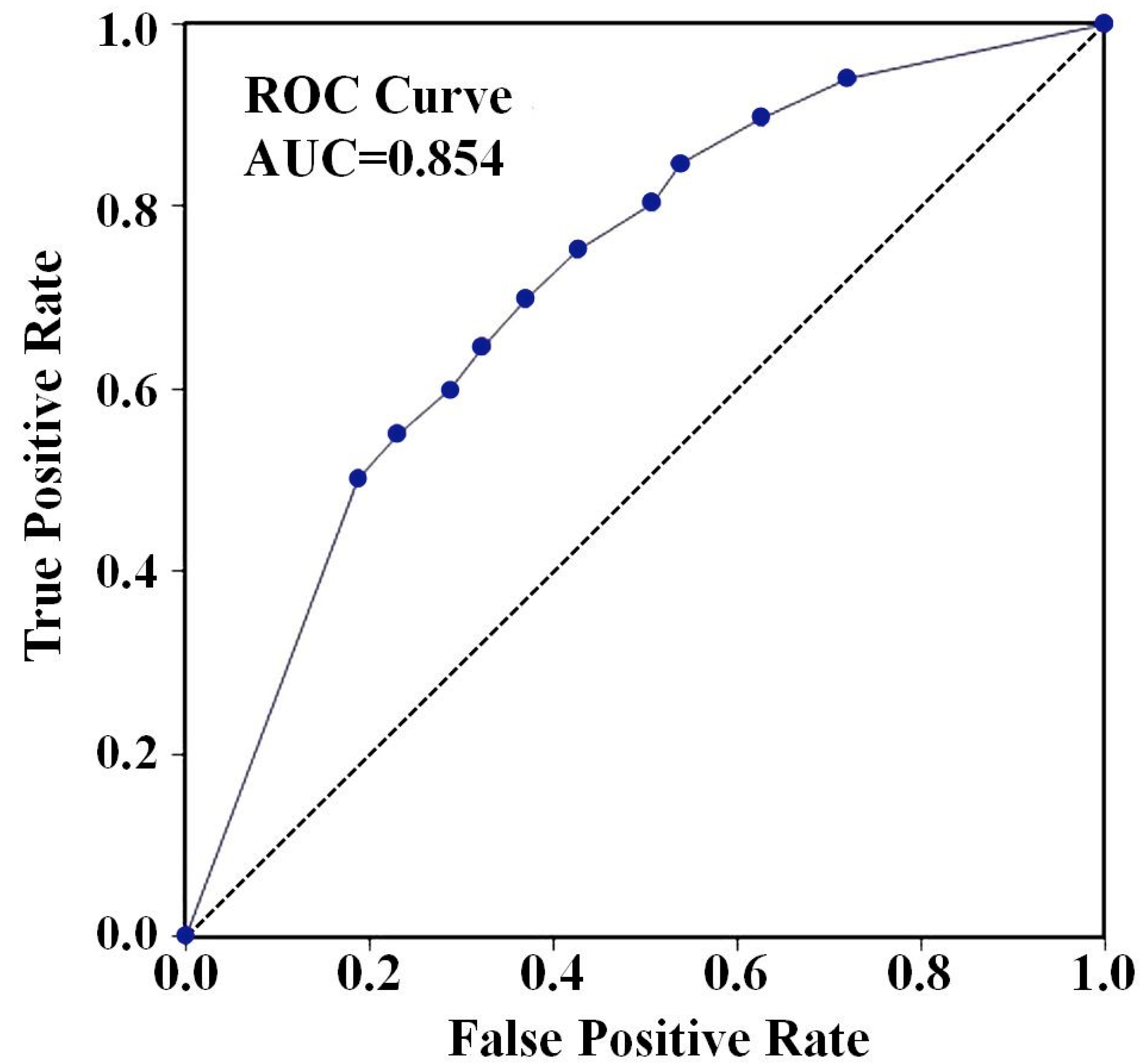
| Nr | Database Name | Type | Structure | Resolution/Scale | Attributes | Acquisition Mode |
|---|---|---|---|---|---|---|
| 1 | Landslides | Vector | Polygon | Orthophotomap/field identification | Location, surface | Primary (vectorization, coordinate measurement) |
| 2 | Level curves | Vector | Line | Equidistance 5 m | Elevation | Primary (vectorization) |
| 3 | Hydrographic network | Vector | Line | 1:25,000 | Name/ Length | Primary (vectorization) |
| 4 | Communication ways network | Vector | Line | 1:25,000 | Indicative | Primary (vectorization) |
| 5 | Built area | Vector | Polygon | 1:25,000 | Name | Primary (vectorization) |
| 6 | Geology | Vector/Raster | Polygon/grid | 1:200,000 | Period/age | Primary (vectorization) |
| 7 | Land use | Vector/Raster | Polygon/grid | 100/100 m | Usage type | Primary (download CLC 2012) |
| 8 | Slope | Raster | Grid | 5 m | Slope values (degrees) | Derivatives (from DEM) |
| 9 | Altitude | Raster | Grid | 5 m | Altitude values (m) | Modelled (from level curves, hydrography and boundary) |
| 10 | Depth fragmentation | Raster | Grid | 5 m | Level difference (m) | Modelled (from DEM and 1000/1000 m grid) |
| 11 | Density of fragmentation | Raster | Grid | 5 m | Values in km/km2 | Modelled (from hydrographic network and 1000/1000 m grid) |
| 12 | Slope orientation | Raster | Grid | 5 m | Orientation type | Derived from DEM |
| 13 | Distance to hydrography | Vector/Raster | Polygon/grid | 5 m | Distances (m) | Modelled (Buffer)/Derived (Vector/Raster) |
| 14 | Distance to roads | Vector/Raster | Polygon/grid | 5 m | Distances (m) | Modelled (Buffer)/Derived (Vector/Raster) |
| 15 | Distance to settlements | Vector/Raster | Polygon/grid | 5 m | Distances (m) | Modelled (Buffer)/Derived (Vector /Raster) |
| 16 | Wetness Index | Raster | Grid | 5 m | WI values | Modelled (from DEM, drainage direction and slope) |
| 17 | Stream Power Index | Raster | Grid | 5 m | SPI values | Modelled (from DEM, flow accumulation and slope) |
| 18 | Validation landslides | Vector | Polygon | Orthophotomap/field identification | Location, surface | Primary (vectorization, coordinate measurement) |
| Landslide Factors | Altitude Ecart | BSA Calculated Value/Ecart | Landslide Area/Ecart (km2) | Area/Ecart (km2) | Susceptibility | Interval |
|---|---|---|---|---|---|---|
| Altitude (m) | 285–400 | 0.198 | 12.55 | 186.45 | Low | −1.516–−1.483 |
| 400–500 | 0.121 | 22.28 | 395.69 | Medium | −1.483–−0.238 | |
| 500–700 | −0.272 | 9.36 | 411.32 | Medium-High | −0.238–0.148 | |
| 700–900 | −1.517 | 0.06 | 44.54 | High | 0.148–0.201 |
| Landslide Factors | Slope Ecart | BSA Calculated Value/Ecart | Landslide Area/Ecart (km2) | Area/Ecart (km2) | Susceptibility | Interval |
|---|---|---|---|---|---|---|
| Slope (degree) | 0–5 | −0.330 | 5.66 | 283.85 | Low | −0.330–−0.293 |
| 5–15 | 0.103 | 36.72 | 679.66 | Medium | −0.293–−0.223 | |
| 15–25 | −0.243 | 1.76 | 72.29 | Medium-High | −0.223–−0.061 | |
| 25–30 | −0.094 | 0.07 | 2.03 | High | −0.061–0.130 | |
| 30–35 | 0.577 | 0.02 | 0.14 | Very High | 0.130–1.149 | |
| >35 | 1.120 | 0.01 | 0.02 |
| Landslide Factors | Aspect | BSA Calculated Value/Ecart | Landslide Area/Ecart (km2) | Area/Ecart (km2) | Susceptibility | Interval |
|---|---|---|---|---|---|---|
| Aspect | Flat | −1.43 | 0.02 | 10.9 | Low | −1.429–−1.394 |
| N | −0.227 | 4.26 | 168.9 | Medium | −1.394–−0.460 | |
| NE | −0.148 | 5.22 | 172.2 | Medium-High | −0.460–−0.047 | |
| E | −0.16 | 4.01 | 136.2 | High | −0.047–0.051 | |
| SE | 0.036 | 5.31 | 114.6 | Very High | 0.051–0.384 | |
| S | 0.336 | 10.86 | 117.6 | |||
| SV | 0.278 | 9.91 | 122.6 | |||
| V | −0.083 | 3.21 | 91.3 | |||
| NV | −0.488 | 1.44 | 103.6 |
| Landslide Factors | Distance (m) | BSA Calculated Value/Ecart | Landslide Area/Ecart (km2) | Area/Ecart (km2) | Susceptibility | Interval |
|---|---|---|---|---|---|---|
| Distance to settlements (m) | 50 | −0.085 | 4.46 | 132.94 | Low | −0.097–−0.090 |
| 150 | 0.184 | 3.68 | 59.16 | Medium | −0.090–−0.067 | |
| 300 | 0.197 | 5.42 | 87.59 | Medium-High | −0.067−0.129 | |
| 600 | 0.126 | 9.57 | 172.12 | High | 0.129−0.186 | |
| 50000 | −0.097 | 19.11 | 586.19 | Very High | 0.186−0.198 |
| Landslide Factors | Distance (m) | BSA Calculated Value/Ecart | Landslide Area/Ecart (km2) | Area/Ecart (km2) | Susceptibility | Interval |
|---|---|---|---|---|---|---|
| Distance to roads (m) | 20 | −0.248 | 0.49 | 21.26 | Low | −0.247–−0.238 |
| 50 | −0.233 | 0.75 | 31.35 | Medium | −0.238–−0.224 | |
| 100 | −0.185 | 1.35 | 50.62 | Medium-High | −0.224–−0.182 | |
| 200 | −0.081 | 3.20 | 94.86 | High | −0.182–−0.077 | |
| 50000 | 0.028 | 36.65 | 839.56 | Very High | −0.077–0.028 |
| Landslide Factors | Distance (m) | BSA Calculated Value/Ecart | Landslide Area/Ecart (km2) | Area/Ecart (km2) | Susceptibility | Interval |
|---|---|---|---|---|---|---|
| Distance to hydrography (m) | 50 | −0.085 | 0.04 | 28.94 | Low | −1.519–−1.455 |
| 150 | 0.184 | 0.17 | 43.14 | Medium | −1.455–−0.993 | |
| 300 | 0.197 | 0.69 | 70.82 | Medium-High | −0.993–−0.572 | |
| 600 | 0.126 | 2.23 | 136.37 | High | −0.572–−0.356 | |
| 50000 | −0.097 | 41.12 | 758.73 | Very High | −0.356–0.110 |
| Landslide Factors | WI | BSA Calculated Value/Ecart | Landslide Area/Ecart (km2) | Area/Ecart (km2) | Susceptibility | Interval |
|---|---|---|---|---|---|---|
| WI | 0–5 | −0.02 | 27.61 | 677.69 | Low | −0.046–−0.042 |
| 5–7 | −0.046 | 4.52 | 117.91 | Medium | −0.042–−0.018 | |
| 7–9 | 0.036 | 6.65 | 143.53 | Medium-High | −0.018–0.039 | |
| 9–11 | 0.115 | 3.82 | 68.80 | High | 0.039–0.110 | |
| >11 | 0.11 | 1.65 | 30.07 | Very High | 0.110–0.116 |
| Landslide Factors | SPI | BSA Calculated Value/Ecart | Landslide Area/Ecart (km2) | Area/Ecart (km2) | Susceptibility | Interval |
|---|---|---|---|---|---|---|
| SPI | >0 | −0.052 | 31.02 | 820.78 | Low | −0.052–−0.039 |
| 0–1 | 0.111 | 6.70 | 121.79 | Medium | −0.039–0.116 | |
| 1–1.2 | 0.168 | 0.92 | 14.70 | Medium-High | 0.116–0.172 | |
| 1.2–1.4 | 0.2 | 0.83 | 12.33 | High | 0.172–0.202 | |
| >1.4 | 0.214 | 4.77 | 68.39 | Very High | 0.202–0.216 |
| Landslide Factors | Land-Use | BSA Calculated Value/Ecart | Landslide Area/Ecart (km2) | Area/Ecart (km2) | Susceptibility | Interval |
|---|---|---|---|---|---|---|
| Land-use | Water accumulation | 0 | 0 | 2.53 | Low | −1.269–−1.199 |
| Airports | 0 | 0 | 0.27 | Medium | −1.199–−0.352 | |
| Water streams | 0 | 0 | 3.09 | Medium-High | −0.352–0.123 | |
| Garbage holes | 0 | 0 | 1.09 | High | 0.123–0.265 | |
| Orchards | 0.211 | 1.31 | 19.71 | Very High | 0.265–0.857 | |
| Swamps | 0 | 0 | 1.36 | |||
| Pine-tree forests | 0 | 0 | 2.20 | |||
| Hardwood forests | −1.27 | 0.42 | 191.3 | |||
| Mixt forests | 0 | 0 | 2.69 | |||
| Secondary meadows | 0.094 | 14.55 | 248.1 | |||
| Discontinuous urban space and rural space | -0.34 | 1.71 | 93.38 | |||
| Arable land not irrigated | -0.04 | 10.81 | 295.4 | |||
| Predominant agricultural land mixed with natural vegetation | 0.487 | 9.16 | 73.28 | |||
| Industrial or commercial units | −0.64 | 0.12 | 13.58 | |||
| Vineyard | 0 | 0 | 4.28 | |||
| Complex crop areas | 0.241 | 4.42 | 62.34 | |||
| Mining areas | 0.124 | 0.18 | 3.32 | |||
| Deforested Areas | 0.268 | 1.59 | 20.08 | |||
| Areas under construction | 0.858 | 0.16 | 0.56 | |||
| Green urban areas | 0 | 0 | 1.99 |
| Landslide Factors | Geology | BSA Calculated Value/Ecart | Landslide Area/Ecart (km2) | Area/ecart (km2) | Susceptibility | Interval |
|---|---|---|---|---|---|---|
| Geology | Andesite | 0 | 0 | 0.14 | Low | −2.055–−1.651 |
| Continental red clay | −2.055 | 0 | 8.91 | Medium | −1.651–−1.269 | |
| Clays, sandstone coal, shale marl, tuffs | 0.286 | 5 | 63.50 | Medium-High | −1.269–−1.184 | |
| Clay, sands, sandstone | −1.337 | 0.33 | 175.88 | High | −1.184–−0.006 | |
| Clay, gravel, sand | 0 | 0 | 0.70 | Very High | −0.006–0.652 | |
| Limestone, marl, gypsum, sandstone, clays | −1.184 | 0.18 | 67.57 | |||
| Conglomerates, sandstones, muddy clays | −0.207 | 5.51 | 138.74 | |||
| Conglomerates, sands, sandstone, marl | −1.266 | 0.15 | 65.90 | |||
| Deluvial-colluvial deposits with blocks | −1.645 | 0.01 | 9.97 | |||
| Sandstone, clay marl | −1.663 | 0.04 | 50.63 | |||
| Marne, sands, gravel | −1.28 | 0.32 | 146.86 | |||
| Marne, coal, limestone | −1.178 | 0.03 | 9.77 | |||
| Marne, tuffs | 0.652 | 28.26 | 155.56 | |||
| Sand, gravel | −0.277 | 2.84 | 132.01 | |||
| Gravels, sands | 0.511 | 1.57 | 11.86 |
| Landslide Factors | m/km2 | BSA Calculated Value/Ecart | Landslide Area/Ecart (km2) | Area/Ecart (km2) | Susceptibility | Interval |
|---|---|---|---|---|---|---|
| Depth of fragmentation | 0–100 | −0.339 | 7.43 | 379.88 | Low | −0.338–−0.329 |
| 100–200 | 0.118 | 36.57 | 654.08 | Medium | −0.329–0.124 | |
| 200–300 | 0.16 | 0.25 | 4.04 | Medium-High | 0.124–0.169 |
| Landslide Factors | km/km2 | BSA Calculated Value/Ecart | Landslide Area/Ecart (km2) | Area/Ecart (km2) | Susceptibility | Interval |
|---|---|---|---|---|---|---|
| Density of fragmentation | 0–1 | 0.109 | 38.13 | 698.83 | Low | −1.279–−1.247 |
| 1–1.5 | −0.252 | 4.70 | 194.01 | Medium | −1.247–−0.687 | |
| 1.5–2 | −0.534 | 1.30 | 104.66 | Medium-High | −0.687–−0.526 | |
| 2–2.5 | −1.279 | 0.07 | 32.53 | High | −0.526–−0.236 | |
| >2.5 | −0.7 | 0.07 | 7.97 | Very High | −0.236–0.123 |
© 2019 by the authors. Licensee MDPI, Basel, Switzerland. This article is an open access article distributed under the terms and conditions of the Creative Commons Attribution (CC BY) license (http://creativecommons.org/licenses/by/4.0/).
Share and Cite
Sestraș, P.; Bilașco, Ș.; Roșca, S.; Naș, S.; Bondrea, M.V.; Gâlgău, R.; Vereș, I.; Sălăgean, T.; Spalević, V.; Cîmpeanu, S.M. Landslides Susceptibility Assessment Based on GIS Statistical Bivariate Analysis in the Hills Surrounding a Metropolitan Area. Sustainability 2019, 11, 1362. https://doi.org/10.3390/su11051362
Sestraș P, Bilașco Ș, Roșca S, Naș S, Bondrea MV, Gâlgău R, Vereș I, Sălăgean T, Spalević V, Cîmpeanu SM. Landslides Susceptibility Assessment Based on GIS Statistical Bivariate Analysis in the Hills Surrounding a Metropolitan Area. Sustainability. 2019; 11(5):1362. https://doi.org/10.3390/su11051362
Chicago/Turabian StyleSestraș, Paul, Ștefan Bilașco, Sanda Roșca, Sanda Naș, Mircea V. Bondrea, Raluca Gâlgău, Ioel Vereș, Tudor Sălăgean, Velibor Spalević, and Sorin M. Cîmpeanu. 2019. "Landslides Susceptibility Assessment Based on GIS Statistical Bivariate Analysis in the Hills Surrounding a Metropolitan Area" Sustainability 11, no. 5: 1362. https://doi.org/10.3390/su11051362
APA StyleSestraș, P., Bilașco, Ș., Roșca, S., Naș, S., Bondrea, M. V., Gâlgău, R., Vereș, I., Sălăgean, T., Spalević, V., & Cîmpeanu, S. M. (2019). Landslides Susceptibility Assessment Based on GIS Statistical Bivariate Analysis in the Hills Surrounding a Metropolitan Area. Sustainability, 11(5), 1362. https://doi.org/10.3390/su11051362










